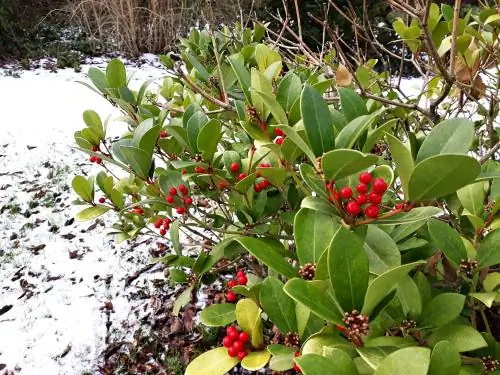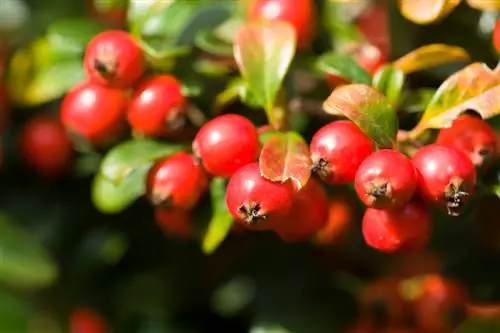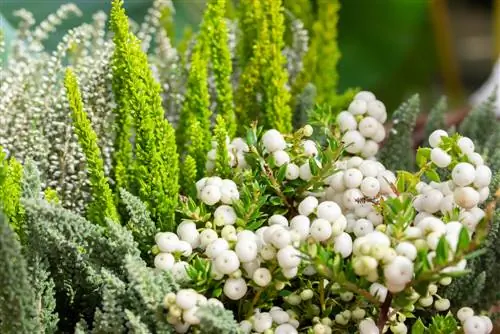- Author admin [email protected].
- Public 2024-01-10 23:11.
- Last modified 2025-01-23 11:22.
She really goes out of her way to pamper us with floral experiences all year round. With evergreen leaves and decorative, fragrant berries, the mock berry guides us through the dark season. Their distinctive pink-white flowers add a cheerful splash of color in semi-shaded, cool locations in summer. Anyone interested in the specific cultivation of dwarf shrubs and ground cover plants will receive well-founded answers to frequently asked questions here.

What do you have to consider when growing and caring for a mock berry?
The false berry (Gaultheria procumbens) is an evergreen dwarf shrub and ground cover that bears pinkish-white flowers in summer and fragrant, red berries in autumn. It prefers partially shaded locations, moist, humus-rich and acidic soil and requires little care. Pruning promotes branching and abundance of flowers.
Planting mock berries correctly
Plant the mock berry either in autumn or spring in a partially shaded location with moist, humus-rich and acidic soil. Place the root ball in a container of lime-free water while you prepare the soil. How to do it right:
- Rake the soil, weed, clean of stones and roots
- Dig small pits at a distance of 25-30 cm with 1.5 times the volume of the root ball
- Mix the excavated material with acidic leaf compost or ericaceous soil
- Plant a young mock berry about 10 cm deeper than it was in the pot so that basal new shoots form
Press the soil, water with soft water and spread a layer of mulch. Leaves, grass clippings and bark mulch are well suited.
Care tips
The following brief overview of the care program makes it clear why the mock berry is so popular with beginners in hobby gardening. Loving attention, coupled with these measures, results in a magnificent ornamental tree:
- Keep the soil constantly slightly moist without causing waterlogging
- Water only with soft water
- From April to August, fertilize every 4 weeks with leaf compost (€59.00 on Amazon) or liquid rhododendron fertilizer
- Moderate pruning by a third, maximum half, in March to mid-April
Winter protection is not necessary in the bed as the mock berry is completely frost-resistant. This requirement does not apply to pots and balcony boxes. Cover the containers with bubble wrap and layer leaves on the substrate.read more
Which location is suitable?
In a partially shaded location, the false berry grows into a floral top form. In shady locations, however, the flowering is usually quite poor, so that only a few berries appear in autumn. Loose, moist garden soil meets your needs perfectly. An acidic pH value is of utmost importance so that the lush heather plant feels in good hands.
The correct planting distance
The mock berry shows off its diverse attributes perfectly as a ground cover. To create a dense, evergreen carpet, distribute 8-10 plants per square meter. As a border for a bed or grave, a distance of 25-30 cm is the right choice. If the mock berry thrives in the balcony box, reduce the value by 5 cm.
What soil does the plant need?
In moist, humus-rich soil with an acidic pH value of 4.5 to 6.0, the essential criteria for optimal soil conditions are met. So that the attractive ornamental tree can unfold its magic in the pot and balcony box, we recommend ericaceous soil, rhododendron substrate or standard soil as a substrate. Adding a few handfuls of lava granules improves permeability.
When is flowering time?
The flowering period of a false berry extends over the months of July and August. In the right location, the ornamental tree delights us with countless white to pink-white mini flowers that stand together in lush clusters. Do not cut off withered flowers, as they will turn into enchanting berry decorations in autumn.
Cut the mock berry correctly
If you cut the 10-20 cm small false berry back by a third or half, this measure promotes further branching and a rich abundance of flowers. The best date for pruning is an overcast, frost-free day between early March and mid-April. At the same time, thin out the dwarf shrub thoroughly so that it doesn't senesce from below.
Watering the mock berry
Don't let a mock berry go thirsty, as drought stress can lead to significant problems. Water the tree abundantly and regularly as soon as the surface of the soil has dried. Do not water the densely leafy plant from above, as in this case not enough water will penetrate to the roots. Apply the water directly to the root disc using the can spout. Only use collected rainwater, descaled tap water or pond water.
Fertilize mock berries properly
The false berry invests all its energy in the distinctive flowers, leaves and berries. Ensure sufficient replenishment with an organic or mineral-organic fertilizer. From April to August, fertilize the dwarf shrub every 4 weeks with acidic compost or liquid rhododendron fertilizer.
Wintering
No measures need to be taken to overwinter a mock berry in the bed. The ornamental tree is completely hardy and, even in bitter frost, sets tireless decorative accents with its leaves and berries. During the cold season, water whenever there is no snow or rain and the soil is dry.
Cultivated in a bucket or balcony box, the root ball should be protected from frost damage. Cover the planter with bubble wrap or jute ribbons. The substrate is covered with a layer of leaves or peat. Adjust the water supply to the reduced demand. Drought stress or waterlogging mean the plant's final demise, even in winter.
Propagate mock berries
The mock berry offers 3 uncomplicated methods of vegetative propagation:
- Cut 5-10 cm small cuttings and let them root in lean substrate
- Cut off the runners, cut them into pieces with 2-3 eyes and let them root in the pot
- Dividing the root ball in spring or autumn
Generative propagation by sowing proves to be delicate and time-consuming. The seeds are poisonous cold germs that germinate only slowly, even after stratification.
Mockberry in a pot
In pots and balcony boxes, the mock berry thrives vitally and he althily in acidic ericaceous soil or rhododendron substrate. A shard of pottery over the water drain prevents waterlogging. The care program does not pose any gardening hurdles. This is how it works:
- Water the substrate whenever the surface is dry
- Apply liquid rhododendron fertilizer every 30 days from April to August
- Before the first frost, place the container on wood and cover it with bubble wrap
- Spread a thick layer of leaves over the substrate
In March/April, cut the dwarf shrub back a little to support further branching. If the pot is completely rooted, repot into fresh substrate.
Is mock berry poisonous?
The name already suggests it. The fruits of a false berry are not suitable for consumption. In fact, the apparently red flesh is thickened sepals that encase a thin-walled capsule fruit containing poisonous seeds. Anyone who eats the fruit will experience symptoms of poisoning, such as nausea, vomiting and cramps. Partridge berries should therefore not be planted within the reach of children and pets. There are no toxic substances in the leaves and shoots.read more






